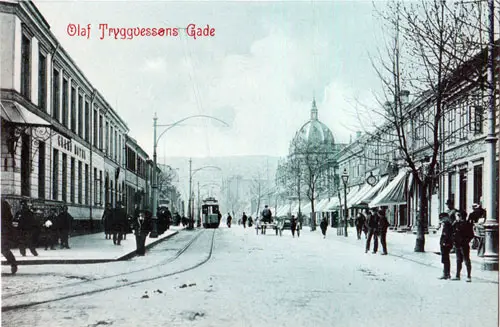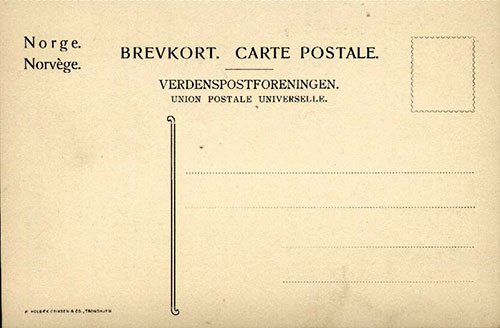Vintage Postcards - Olaf Tryggvessøns Gade - Trondheim, Norway
Olaf Tryggvessøns Gade is now Olav Tryggvasons gate.
Olav Tryggvason street is the northernmost of the five east-west cross streets Trondheim got by the new town plan of 1681 - see Trondheim's history.
Around the same place went Lower commons in the Middle Ages. The street runs from Bakke bridge in the east to Prince Street in the west, where it continues westward Sandgata. Olav Tryggvason street was formerly Strand Street.
The fire in 1841 let all buildings in ruins, but within a few years, the street was rebuilt with a two-story wooden house - most with business in the first and apartments on the second floor.
There is a farm that houses Nova cinema on the corner of Krambugata People's houses. Here lay the Grand hotel until the labor movement bought the property in 1915. The new People's House was completed in 1943, with Jakob Holmgren as an architect.
Through many years held center cinema to a part of the building. People's House was an excellent example of classic functionalist until the facade was faced with brick. The farm was in 1994 completely remodeled inside to multi cinema building.s - Nedre Lerfos - Trondheim, Norway

Street Scene during the winter of Olaf Tryggvessøms Gade in Trondhjem. Streetcars on one side and pedestrians the primary mode of transportation on the other side. Also visible in this scene is a horse-drawn cart.
Title: Olaf Tryggvessøns Gade
PC Mfg. Nbr.: N/A
Manufacturer: J. Holbæk Eriksen & Co., Trondhjem
Date: Undated but circa 1905
Manufactured: Unknown
Photographer: Unknown
Archives Inventory Number: GGA-ATL 160306010

Klein farm vis-à-vis (no. 2b) forms the beginning of a row of houses down the Krambugata, often called Jugend Quarter. The buildings are built in 1908 and designed by Hagbarth Schytte-Berg.
Matheson farm on the corner of Søndregate (no. 14) was erected in 1898 as manufakturmagasin for merchant Jacob Matheson. The building is an example of the so-called Berliner-Renaissance building designed by Karl Norum.
Lysholm farm is designed by Arne Vesterlid and was erected in 1933 on the site of former Lysholm Aquavitdestillasjon. The building is an example of an early functionalist in Trondheim. It is characterized in particular by the asymmetrically placed slab tower.
The farm had from the start ground-floor shops, a restaurant on the second and offices in the other; 1999 constitutes the farm part of the mall Byhaven.
No. 40 on the corner of Munkegata against Ravnkloa is the so-called Holbæk Eriksen farm called Klüwergården. It was built for merchant Lorentz Diderich Klüwer in 1899 and was designed by Lars Solberg and Johan Christensen. Stylistically, the building can be characterized as historicism in a romantic direction. It was initially built as department stores with businesses on the first floor and offices on the other.
Thaulow farm on the other side of Munkegata (no. 42) is an excellent example of a wooden palace from the 1700s, in empire with monumental double staircase and Ionic columns in the entrance portal. It was built in 1807 for merchant Peter Falch.
